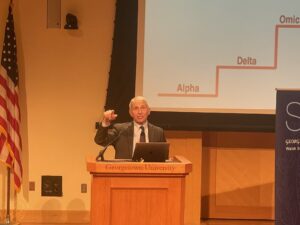Per a Dec. 29 pair of emails from Georgetown Provost Robert Groves and President John DeGioia, main campus students will be permitted to return to Georgetown beginning Jan. 11, though classes will occur virtually until Jan. 30. Yet despite increased COVID risk posed both by record-high D.C. caseloads and the highly transmissible nature of the Omicron variant, university COVID policy has changed little. We believe this is unacceptable and dangerous. Changes to the testing regime, academic flexibility, masking compliance, and more are critical steps towards preventing a public health catastrophe in the weeks to come. Students, too, must take responsibility for limiting COVID spread: When Georgetown’s policies fall short, we can still take steps to keep the community safe.
While students are on the whole a young and healthy group, we cannot ignore the risk that COVID still poses—if not to us, to those around us. The Omicron variant is infecting and hospitalizing young people at higher rates, and no matter how severe the case is, the possibility of long COVID leading to loss in physical and mental function is ever-present. Staying uninfected is even more imperative for those who are disabled and/or immunocompromised (at least one of your friends probably is in some way), workers who commute to campus, and older community members like faculty and staff. Not to mention the larger D.C. community we live in—Georgetown is no vacuum, and spreading COVID remains a racial justice issue. Yes, if you get COVID, in all likelihood, you will survive. But you should still take reasonable measures to avoid it for the sake of our community.
Mandatory weekly testing now
First and foremost, Georgetown must increase the frequency and rigor of its testing regime. Currently, for fully vaccinated undergraduates, Georgetown utilizes a voluntary testing policy. Voluntary testing is most useful when detecting symptomatic COVID cases—a student exhibits a runny nose or a sore throat, gets tested, and is isolated upon a positive result. Yet global studies have estimated that as many as 40 percent of COVID cases are asymptomatic, and that this trend is especially prevalent among younger COVID patients. High asymptomatic transmission risk means mandatory regular testing—regardless of symptoms—is imperative towards identifying cases early on.
We recommend at least weekly mandatory testing tied to building access, a protocol previously in effect during summer 2021 for the Summer Hilltop Immersion Program. The ability to access university buildings should be contingent on taking the precautions necessary to keep those around them safe. And that means testing regularly.
It’s frustrating that Georgetown continues to pursue voluntary testing when so many other campuses—including seven out of the ten “peer campuses” identified by Georgetown and numerous others both in (e.g. Howard, GW) and out (e.g. Harvard, Yale, Stanford) of the D.C. area—have mandatory testing policies, as of Dec. 31. A frequent and enforceable testing cadence is necessary for accurate public health data and isolation protocol triggers, and for students to be minimally safe on campus come Jan. 11, Georgetown must implement such a policy immediately.
Arrival testing, too, must undergo revision. Given that the median incubation period for COVID is 4-5 days, mandatory testing 3-5 days after arrival on-campus should also be part of the equation. Even the Omicron variant’s apparent 72-hour incubation period could be overlooked by the current arrival testing regime that involves two PCR tests within 48 hours of each other. Moreover, policy that discriminates between travelers within the DMV area and outside of the DMV area is outdated, given that D.C. has been reporting more recent cases per capita than any state. Arrival protocol should be equally rigorous for all students returning to the Hilltop.
Of course, should the university fail to implement these testing policies, the student body should adopt its own culture of testing (at minimum) weekly, and we should hold ourselves and our friends accountable to regular testing. What takes five to ten minutes a week keeps us all safer and healthier.
Change student conduct norms
Common sense (and CDC recommendations) make it clear that if COVID is transmitted, it’s less likely to be in a classroom when everyone is masked, than at bustling social events like dinners, wine nights, and parties. While Georgetown has yet to issue any new guidelines regarding social events, we need to implement our own rules when hosting or attending social gatherings. This is particularly important because we’re skeptical of university-enforced party capacity caps—in theory fantastic, but in practice policed in racist and unjust ways, when enforced at all.
As social creatures ourselves, we’d be hypocrites if we asked others to stay inside and alone. But there are clear strategies for mitigating the spread of COVID at large events that many successfully implemented last semester. Given that in areas of high transmission (like D.C.) there’s a 95 percent chance a gathering of 25 or 30 people will include someone with COVID, the decisions we make about social events could prevent or incite an outbreak reaching dozens of students.
If you’re considering hosting a party or larger event, the most responsible prevention measure is requiring proof of a negative COVID test from the last 48 hours for entry (a requirement that would be made easier by aforementioned mandatory university testing). While this won’t catch all positive cases, it’s the surest strategy and when combined with masks and other prevention measures (not sharing drinks/using communal cups for games) can prevent your celebration from becoming a superspreader.
Basic compliance with university guidelines about masking in indoor public spaces—we’re looking at you, Lau 2 and Sellinger occupants—will also be necessary. Having a drink in front of you is not an excuse to take your mask off for hours on end. We understand the urge to unmask, but the student body has to collectively take more personal responsibility for transmission if we’re to tide through these coming weeks.
These measures can feel overbearing, especially when you’re the one who has to implement and enforce them. But D.C. case rates now are higher than at any point in the pandemic, including the year we weren’t even at Georgetown. A little extra caution is not only justified; it is required.
Take no isolation risks
This week, the CDC made waves when they announced their recommended quarantine time was decreasing from 10 days to five, a move many see as intended to get workers back to their jobs faster regardless of the health consequences. Georgetown has not yet updated their policy on quarantine time for positive COVID cases, but it’s imperative they let students stay in the hotel for the full ten days. Without the confirmation of a negative test before leaving isolation, a shorter quarantine period can bolster the spread of COVID from people who think their illness is over. Further, the new CDC guidelines say masks must be worn at all times indoors the five days following quarantine, a rule the university cannot effectively enforce in social events or residences. To prevent spread from already identified COVID cases, the current quarantine policies must remain.
However, current university isolation policies for non-confirmed cases do fail students by allowing those who have had close contact with a positive case to continue to go about normal activities and interact with the community, even though doing so could expose many more to COVID. Even if professors unfairly expect you to attend class following exposure, you should isolate as much as you can—take food from Leo’s to go, decline social invitations, and back out of all club activities. Make sure you get two or three negative tests, and wait until at least five days after exposure before you decide you’re in the clear. It won’t be the best week of your life for sure, but it’s far better than infecting your friends and knowing you could have prevented it.
De-densify dining
Changing the meal plan requirement for students who live in spaces with kitchens is an easy way for the university to de-densify its dining areas. As the Editorial Board has argued, the meal plan requirement does little to improve COVID safety: underclassman students are forced to wait in longer lines, and upperclassman students are financially pushed into utilizing the dining hall instead of their own food preparation areas. Offering lower-tier meal plan options alongside the grab-and-go model (or scrapping the requirement altogether) can help facilitate a safer dining experience.
Increase academic flexibility through add/drop, professor understanding
With classes entirely online for the first two weeks, Georgetown should push back the Jan. 21 add/drop deadline to at least Feb. 4, which would give students a week of in-person classes in addition to the two weeks online. This would also push back the “withdrawal” deadline, meaning students have more time to drop a class without the “W” mark on the transcript.
Why? The expectations, experience, and dynamic of an in-person class can be significantly different than a virtual one for students. Without an extended add/drop window, students would be placed in a catch-22: either taking on a withdrawal that may damage perception of their academic record, or biting the bullet with a course that may undergo great material change when moving to an in-person format. The decision to go virtual for the first few weeks is a sound one, but it must be implemented in a way that does not harm students academically.
On that same note, it has grown even more imperative that professors are flexible with students, as isolation and quarantine rates are sure to increase this semester. Even without symptoms, students last semester reported COVID delayed their academic progress and threw a wrench in the semester. Professors should not expect students experiencing symptoms to work at all while quarantined, and certainly not at their usual rate. They must be more flexible with deadlines to ensure students can actually focus on recovering. While we should do what we can to avoid contracting COVID, getting it should not doom someone to a subpar semester.
Care now means more later
We think the university’s plan to move in-person classes back to the 30th is a good move to begin de-densifying campus while riding out the Omicron peak; this measure protects faculty members from risk of exposure and still ensures students can access campus, which many have expressed is key to mental health needs. But if we are to keep people safe from COVID and its possible long-term side effects, the university and student body alike need to take serious steps.
We don’t say all this lightly—one of us will be making the same sacrifices outlined above during her last semester of college. But we are so privileged to live in a place where we have access to regular testing, can miss class or work to isolate, and still spend the semester with our friends. It’d be a tragedy not to take advantage of that. And who knows? An abundance of caution now might be our only path towards an abundance of fun at the semester’s end.




